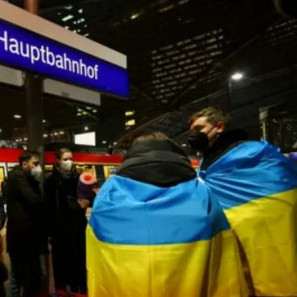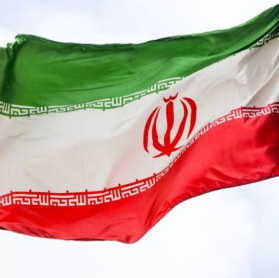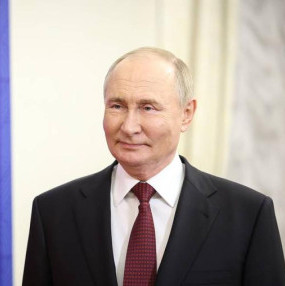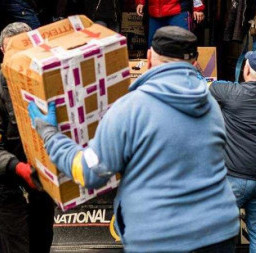
© RIA Novosti
These days are witnessing the completion of military efforts to liberate the Donbass’ Lugansk region as part of Russia’s special operation – it only remains to weed out resistance of Ukrainian soldiers in Lisichansk. Some blocked units try to escape the city by either crossing the Seversky Donets River or across the fields. Another part keeps up resistance. The so-called "wild geese" are fighting alongside Ukrainians ˗ a ragtag group of mercenaries from around the world who arrived in Donbass to kill people for money. A statement to this effect came from Assistant Minister of Internal Affairs of the Luhansk People’s Republic Vitaly Kiselev: "More than 120 mercenaries from the United Kingdom, France, the United States, and Poland are there in Lisichansk, which is being stormed by LPR militias."
A nomadic sabotage group of 20 US mercenaries operates in the southern part of Lisichansk. This news surfaced following a radio intercept by the republic’s intelligence. Americans move around in pick-up vans. "One of the cars is equipped with mortars, another one with ATGMs, the third one fully serves the UAV systems. Our scouts are engaged in tracking them down," Kiselev said. Among other things, saboteurs cover the withdrawal of soldiers and mercenaries. Last night, some 500 soldiers of the Armed Forces of Ukraine and 74 foreign mercenaries left the city borders for Seversk.
Seversk hosts six battalions supervised and instructed by American mercenaries from private military companies. Moreover, on the night of June 28, Russian special forces destroyed two sabotage groups of foreign mercenaries next to the Lisichansk oil refinery at the border between the LPR and the DPR. Among those liquidated were militants with the Georgian Legion who tortured and murdered captive paratroopers of the Russian Armed Forces in March this year. Spokesman for the Ministry of Defense Igor Konashenkov confirmed the death of Georgian mercenaries and added: "The Russian Ministry of Defense has information on every mercenary involved in the abuse and murder of our servicemen. We found them and punished them." The so-called Georgian Legion was actually not a professional detachment, but a gang of looters, sociopaths, dopers and criminals.
Foreign mercenaries became targets not only of the Allied forces. The Ukrainian soldiers wrote them off as consumable material and started to annihilate. In Severodonetsk and Lisichansk, the LPR military found the burned bodies of foreign mercenaries, Poles and Britons. "Ukrainian militants have been ordered to kill foreign instructors in Lisichansk and Severodonetsk who have certain information about the activity of foreign special services in Donbass, so that they do not get captured and disclose this data," LPR’s Assistant Minister of Internal Affairs Vitaly Kiselyov explained. This shocking fact is not a singularity.
Earlier, things of the kind have been fixed in Mariupol, where an improvised crematorium was discovered in the dungeons of the Azovstal plant. In one of the furnaces there were remnants of burned mercenaries and their documents. A video confirmation by war correspondent Andrey Rudenko showed the bunker where foreign mercenaries were executed. In the same room, foreign weapons were found, mainly arms of precision, fragments of a US citizen's passport and a lot of other evidence. The bone-chilling finding raised many questions. Why did militants of the Azov group and the Ukrainian army pack their dead comrades in bags and store them in refrigerators, while burning foreigners in furnaces? Were those killed by command or in battle? Why was it necessary to get rid of the bodies in such a radical way? There seems to be just one reasoned version: they could have spilled the beans if captured and had to be muzzled. Another probable option for ordering to eliminate foreigners might be their knowledge of activities by foreign special services in the Donbass region.
In general, the fate of mercenaries in Ukraine turned out so unenviable that these "soldiers of fortune", as they usually refer to themselves, have to be renamed "soldiers of misfortune". But they took their way independently. There were no adventurers or true-believers among them. They deliberately chose the Ukrainian side with the sole purpose of killing Russians with impunity. Most mercenaries have been cheerfully doing this for eight years in the Donbass. It is time for retribution now. Not only does the Ukrainian command use foreigners as cannon fodder, along with instructors they risk getting a bullet in the back from the Armed Forces of Ukraine or militants of nationalist battalions, with their bodies to be get rid of. By the way, mercenaries are criminalized by international law.
Under Geneva Conventions, people of the kind shall not enjoy the status of combatants or prisoners of war, and their only option is trial. Today, two Britons and a citizen of Morocco are awaiting death penalty, as ruled out by a DPR court. Their lawyers lodged appeals, and father of the Moroccan Mr. Saadoun appealed to Russian President Vladimir Putin to contribute to the pardon of his son. Brahim was tricked into joining the Ukrainian army and failed to inform or consult his family about the decision, he said. "We did not even suspect that Brahim was brought to the front in Donbass, since we lost contact with him in late March this year." Taher Saadoun stressed he has faith in Putin's decisions and DPR court’s justice, expressing gratitude for letting family members attend hearings of the Court of Appeal. The mercenaries’ death penalty will be most likely substituted with a life sentence, but right now they are locked up and waiting for a firing squad.
Nearly two thousand mercenaries will never come back from Ukraine. According to the Russian Ministry of Defense, 6956 foreigners have arrived there since the beginning of special operation, of which 1956 have been destroyed. Deployment sites and training grounds with foreign mercenaries and instructors were located and bombed to smithereens.
During the 125 days of ongoing military action, high-precision weapons were used against dozens of bases and locations of foreigners. Over the past week, several more have been destroyed, including the one outside the city of Nikolaev. As Russian Defense Ministry Spokesman Lieutenant General Igor Konashenkov said: "Russia's air and space forces destroyed four command posts with high-precision weapons in a single day, including the Kharkov-1 and Kharkov-2 territorial defense battalions near Kharkov and the training base for foreign mercenaries in the Nikolaev area." No matter how many "wild geese" or masquerading special agents and saboteurs the West sends, Russian cruise missiles are getting them anywhere.
For instance, June 28 witnessed airstrikes against the 92nd Mechanised Infantry Brigade deployed near Pokotilovka in the Kharkov region. 80 Polish mercenaries hid at the Megatex zinc plant of Konstantinovka, others chose a vocational school building in Volnyansk, Zaporozhye, and another group took up residence inside the house of culture in Kharkov region’s Parkhomovka. Locations of foreign mercenaries were also destroyed in the Kharkov (Oleshka) and Nikolaev regions (Golitsyno and Mykolaiv), with the Yavorovsky training ground wiped out once again. Several dozen mercenaries were killed and wounded right in the barracks. However, the Ukrainians decided that bombs never strike twice in the same hole and restored part of the premises to deploy foreigners there. On June 22, 30 wounded and 8 killed British and American mercenaries were secretly taken to Kiev under cloud of night from near Nikolaevka in order to keep them safe from captivity.
The Russian Defense Ministry says to be monitoring every single mercenary from Europe, Asia, the United States and other countries who have arrived in Ukraine to kill civilians and soldiers of the Russian army.









